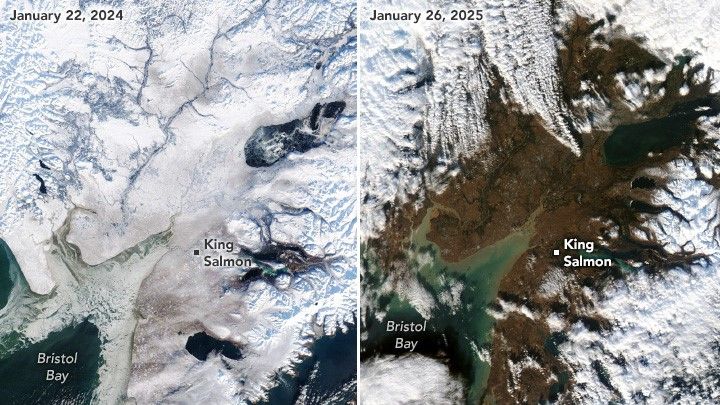
Is More Global Warming Hiding in the Oceans? (Op-Ed)

Jeff Nesbit was the director of public affairs for two prominent federal science agencies and is a regular contributor to U.S. News & World Report, where this article first ran before appearing in LiveScience's Expert Voices: Op-Ed & Insights.
The HMS Challenger set sail 135 years ago. It was the world's first scientific survey of ocean life. But, the HMS Challenger also studied ocean temperatures along the way by dropping thermometers attached to Italian hemp ropes that stretched hundreds of meters deep — an effort that has been used as a baseline for global warming in oceans since pre-industrial times.
Now, according to a new study, U.S. and Australian researchers have combined the work of the HMS Challenger with modern-era climate science models — and have some surprising results. The study found we may be significantly under-estimating global warming's impact and heat content in the oceans; and, sea level rise from global warming seems to be split 60/40, with 40 percent coming from expansion of sea water caused by warming, and the remaining 60 percent coming from melting ice sheets and glaciers.
The U.S. and Australian researchers who re-examined the HMS Challenger thermometer readings in light of modern supercomputer climate models say it provides further confirmation of human-produced global warming over the past century.
"Our research revealed warming of the planet can be clearly detected since 1873 and that our oceans continue to absorb the great majority of this heat," said Will Hobbs, the study's lead author and a researcher at the University of Tasmania's Institute for Marine and Antarctic Studies. "Currently, scientists estimate the oceans absorb more than 90 percent of the heat trapped by greenhouse gases, and we attribute the global warming to anthropogenic causes."
The HMS Challenger expedition ran from 1872 to 1876, and was the world's first global scientific survey of life beneath the ocean surface. But, while it wasn't part of its central research mission, the Challenger also dropped thermometers deep into the ocean at different points. More than a century later, researchers used state-of-the-art climate models to get a more accurate picture of how the world's oceans have changed since the Challenger's voyage.
"The key to this research was to determine the range of uncertainty for the measurements taken by the crew of the Challenger," said Josh Willis, a study co-author who is a climate scientist at NASA's Jet Propulsion Laboratory. "After we had taken all these uncertainties into account, it became apparent that the rate of warming we saw across the oceans far exceeded the degree of uncertainty around the measurements. So, while the uncertainty was large, the warming signal detected was far greater."
Sign up for the Live Science daily newsletter now
Get the world’s most fascinating discoveries delivered straight to your inbox.
Because it was the first expedition of its kind, there were a number of uncertainties around the HMS Challenger expedition. For instance, the Challenger could only drop thermometers in a limited number of areas in oceans . As it turns out, some of the places it chose — modern science now knows — are places that are warmer than usual.
The Challenger also could only guess about depths for the ropes that held the thermometers — there were no unmanned submersibles in those days — and they also could only guess at the natural variations in temperatures that could occur in different ocean regions during the expedition.
To account for these sorts of uncertainties with modern-era models, the researchers used the most conservative estimates they possibly could, taking into account the maximum possible variation from the uncertainties. Even taking this approach, the researchers found that global warming has clearly occurred in the world's oceans and is likely higher than what we know.
"Because we took the most conservative outcome, we are likely to have underestimated the true temperature rise," said Hobbs. "A simple analysis of our results suggests we may have underestimated the warming by as much as 17 percent. In fact, many of the stations most prone to bias were in the Eastern Pacific — a region showing one of the strongest ocean warming trends — so the true warming may be even larger than that."
While discovering that there was an increase in warming in ocean temperatures in the past century, the researchers were also able to clearly show the amount of thermal expansion in sea level rise in the oceans before the 1950s. Prior to this research, climate models offered the only way to estimate the change.
"This research adds yet another suite of compelling data that shows human activity continues to have a dramatic influence on the Earth's climate," Hobbs said.
This research on ocean heat content comes at a critical moment in the discussion of global warming. A leading climate scientist, Kevin Trenberth, recently wrote in a blog post for The Conversation that we may be vastly under-estimating just how much global warming is hiding in the world's oceans — and, that we may need to re-define the way we think about global warming.
"Rising surface temperatures are just one manifestation. Melting Arctic sea ice is another. So is melting of glaciers and other land ice that contribute to rising sea levels. Increasing the water cycle and invigorating storms is yet another," wrote Trenberth, who is a senior scientist at the National Center For Atmospheric Research in Boulder, Colorado.
"But, most (more than 90 percent) of the energy imbalance goes into the ocean, and several analyses have now shown this. But even there, how much warms the upper layers of the ocean, as opposed to how much penetrates deeper into the ocean where it may not have much immediate influence, is a key issue," he continued. [Surprising Depth to Global Warming's Effects]
Trenberth and some of his colleagues recently published a new analysis of their own which shows that, in the past decade, roughly 30 percent of global warming heat may be hiding below 2,000 feet in the world's oceans — essentially, in the bottom half of most of the oceans where very little observational research has been done. That's a significant analysis — because there has been virtually no research on missing heat at the deepest depths of the world's oceans (below 700 meters).
"The cause of the shift is a particular change in winds, especially in the Pacific Ocean where the subtropical trade winds have become noticeably stronger, changing ocean currents and providing a mechanism for heat to be carried down into the (deep) ocean," Trenberth wrote. "This is associated with weather patterns in the Pacific, which are in turn related to the La Niña phase of the El Niño phenomenon."
Trenberth predicted that some of this "missing heat" will return at some point — with long-term consequences.
"Some of the penetration of heat into the depths of the ocean is reversible, as it comes back in the next El Niño," he wrote. "But a lot is not; instead it contributes to the overall warming of the deep ocean. This means less short-term warming at the surface, but at the expense of greater long-term warming, and faster sea levels rise. So this has consequences."
But one thing is abundantly clear, Trenberth wrote. Despite the ups and downs of ocean heat, the La Niña / El Niño cycles and solar cycles that impact surface temperature from year to year, global warming is here to stay.
"The past decade is by far the warmest on record," he wrote. "Human induced global warming really kicked-in during the 1970s, and warming has been pretty steady since then."
Read Nesbit's most recent Op-Ed: Is China Mining a Rare Earth Monopoly?
This article first appeared as Is More Global Warming Hiding in the Oceans?in the column At the Edge by Jeff Nesbit on U.S. News & World Report. The views expressed are those of the author and do not necessarily reflect the views of the publisher.
The views expressed are those of the author and do not necessarily reflect the views of the publisher.
Most Popular




